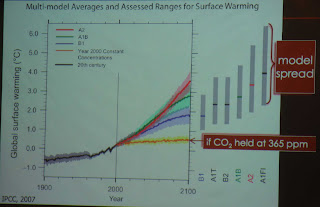 and the CO2 concentrations comparable to today's. Her argument is that we as a community can perfect today's global models by seeing if we can make them work in relation to the situation in the Pliocene Era (4.5 M to 3.0 M years ago). I agree with that, with the caveat that the oceans may have had a significantly different thermal and chemical structure then as compared to today.
and the CO2 concentrations comparable to today's. Her argument is that we as a community can perfect today's global models by seeing if we can make them work in relation to the situation in the Pliocene Era (4.5 M to 3.0 M years ago). I agree with that, with the caveat that the oceans may have had a significantly different thermal and chemical structure then as compared to today. [As you can see from the graph to the left, CO2 is rising rapidly, and even the slope may be increasing. Cause for concern.]

[In the graph to the left, there is a range of uncertainty to the current models. These uncertainties turn out to be very important, as I will be discussing in a later post. Global warming could be greater than is commonly projected for use in government policy decisions.]
In addition there is a more controversial conjecture that I would make. If you look at the analytical climate models of today you see projections of several degrees of temperature rise by 2050 or 2100. If you look at the MIT model (which I will discuss in a later entry), you see that the global temperature is still rising at 2050 or 2100 even if we keep CO2 equivalents down to the present level. This is consistent with a longterm asymptotic temperature shift such as Christina found in the geologic record: 4 to 9 degrees centigrade. This is of course much greater than the temperature change predicted by analytical models. These values could be conservative because of the large amounts of anthropogenic carbon introduced through burning of fossil fuels as well as conversion of biomaterials currently frozen into permafrost to methane. If these asymptotic values are accurate then the big question is the rate at which the asymptotic limits are achieved.
The intriguing pattern that Christina noted was that much of the global warming effect for the U.S. geographical area during the Pliocene was a warming in the northern parts of North America (pretty nice except for the resulting melting of the permafrost) and increased El Nino effects where they are only occasional now in the Southwest. Here is the map of effects:

You see the term El Padre that she has created. She uses that term because it is like El Nino but different in that it can be more usual and the conditions that lead to it can be quite different from what currently creates El Ninos.

No comments:
Post a Comment